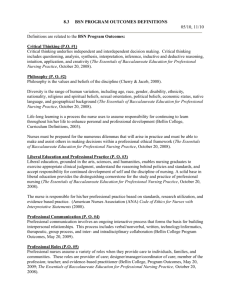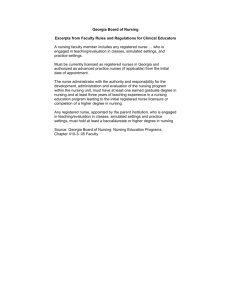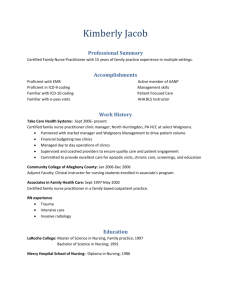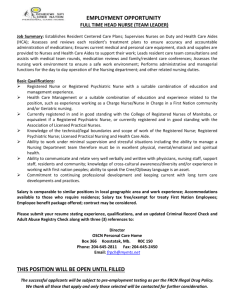BSN Program Outcomes..
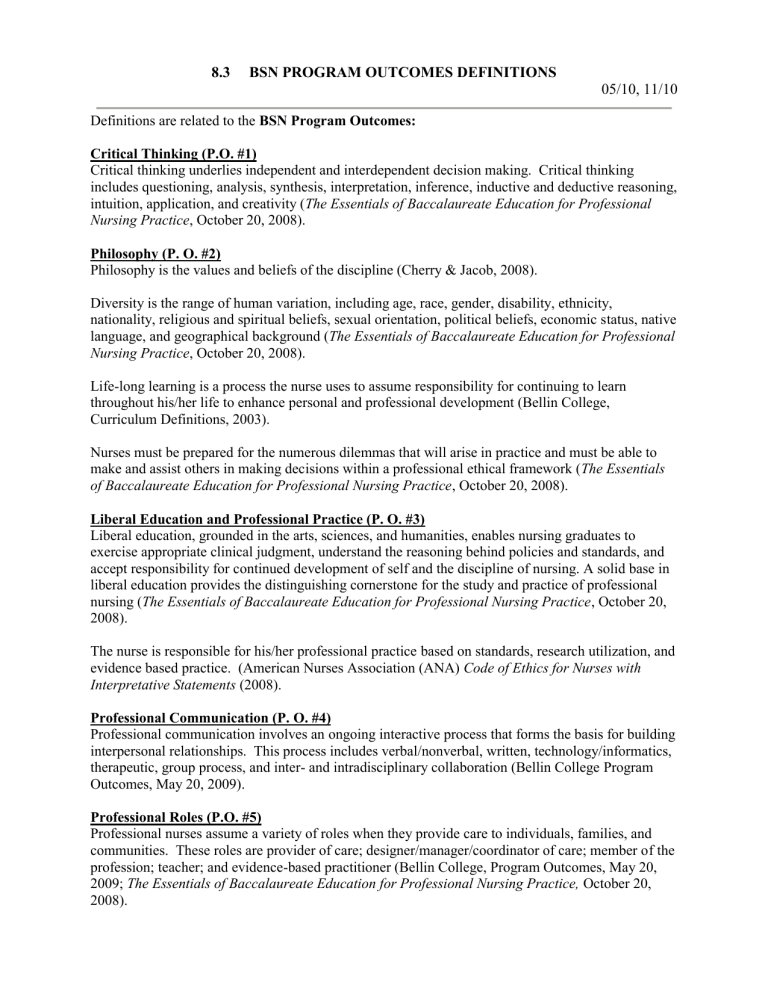
8.3 BSN PROGRAM OUTCOMES DEFINITIONS
05/10, 11/10
Definitions are related to the BSN Program Outcomes:
Critical Thinking (P.O. #1)
Critical thinking underlies independent and interdependent decision making. Critical thinking includes questioning, analysis, synthesis, interpretation, inference, inductive and deductive reasoning, intuition, application, and creativity ( The Essentials of Baccalaureate Education for Professional
Nursing Practice , October 20, 2008).
Philosophy (P. O. #2)
Philosophy is the values and beliefs of the discipline (Cherry & Jacob, 2008).
Diversity is the range of human variation, including age, race, gender, disability, ethnicity, nationality, religious and spiritual beliefs, sexual orientation, political beliefs, economic status, native language, and geographical background ( The Essentials of Baccalaureate Education for Professional
Nursing Practice , October 20, 2008).
Life-long learning is a process the nurse uses to assume responsibility for continuing to learn throughout his/her life to enhance personal and professional development (Bellin College,
Curriculum Definitions, 2003).
Nurses must be prepared for the numerous dilemmas that will arise in practice and must be able to make and assist others in making decisions within a professional ethical framework ( The Essentials of Baccalaureate Education for Professional Nursing Practice , October 20, 2008).
Liberal Education and Professional Practice (P. O. #3)
Liberal education, grounded in the arts, sciences, and humanities, enables nursing graduates to exercise appropriate clinical judgment, understand the reasoning behind policies and standards, and accept responsibility for continued development of self and the discipline of nursing. A solid base in liberal education provides the distinguishing cornerstone for the study and practice of professional nursing ( The Essentials of Baccalaureate Education for Professional Nursing Practice , October 20,
2008).
The nurse is responsible for his/her professional practice based on standards, research utilization, and evidence based practice. (American Nurses Association (ANA) Code of Ethics for Nurses with
Interpretative Statements (2008).
Professional Communication (P. O. #4)
Professional communication involves an ongoing interactive process that forms the basis for building interpersonal relationships. This process includes verbal/nonverbal, written, technology/informatics, therapeutic, group process, and inter- and intradisciplinary collaboration (Bellin College Program
Outcomes, May 20, 2009).
Professional Roles (P.O. #5)
Professional nurses assume a variety of roles when they provide care to individuals, families, and communities. These roles are provider of care; designer/manager/coordinator of care; member of the profession; teacher; and evidence-based practitioner (Bellin College, Program Outcomes, May 20,
2009; The Essentials of Baccalaureate Education for Professional Nursing Practice, October 20,
2008).
Provider of Care: The nurse integrates theory and research-based knowledge into nursing practice to assist patients with health promotion and maintenance, disease prevention, illness management, and end-of-life care.
Designer/Manager/Coordinator of Care: The nurse, as a designer/manager/coordinator of client care, uses a variety of resources to guide and direct patient outcomes within the health care delivery system. Strategies such as communication, collaboration, delegation, negotiation, teamwork, fiscal planning and the application of outcome-based practice models are implemented to analyze and evaluate the quality of nursing care (delivered or provided).
Member of the Profession: The nurse, as a member of the profession, practices within an ethical framework consistent with the ANA Code of Ethics . As advocates for high quality care, nurses must be knowledgeable and active in the political and legal processes related to health care delivery. The nurse is committed to life-long learning and advancement of the profession.
Teacher: The nurse assists patients to acquire and interpret knowledge, skills, and attitudes that focus on health promotion and maintenance, disease prevention and illness management.
Evidence-based Practitioner: The nurse uses a critical thinking approach that involves collection, critical analysis and interpretation of data to gain new knowledge or to verify existing knowledge.
Health Promotion and Maintenance (P.O. #6)
Activities that have as their goal the development of human attitudes and behaviors that maintain or enhance well-being (Stanhope & Lancaster, 2008).
Disease Prevention (P. O. #6)
Activities that have as their goal the protection of people from becoming ill because of actual or potential health threats (Stanhope & Lancaster, 2008).
Illness Management (P.O. #6)
Activities that implement holistic, patient-centered care for managing the acute and chronic needs of patients across the lifespan ( The Essentials of Baccalaureate Education for Professional Nursing
Practice, October 20, 2008).
References
American Association of Colleges of Nursing (October 20, 2008). The Essentials of Baccalaureate
Education for Professional Nursing Practice , Washington, DC.
American Nurses Association (ANA) Code of Ethics for Nurses with Interpretative Statements
(2008).
Cherry, B., & Jacob, S. (2008). Contemporary Nursing: Issues Trends & Management (4th ed.). St.
Louis: Mosby Elsevier.
Stanhope, M. & Lancaster, J. (2008). Public health nursing: Population-centered health care in the community (7 th
ed.). St. Louis, MO: Mosby).
